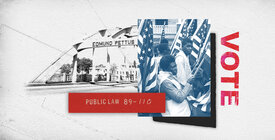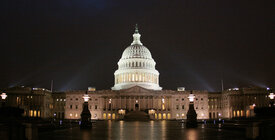Update 4/24/25: A federal court has temporarily blocked the U.S. Election Assistance Commission from implementing a mandate in the president’s executive order to add a requirement to show a passport or similar document proving citizenship when registering to vote via the federal form.
President Donald Trump last Tuesday issued an executive order that aims to illegally overhaul and take control of major parts of the nation’s election systems. He claimed extraordinary unilateral authority to regulate federal elections and usurp the powers of Congress, the states, and an independent bipartisan federal agency. This violates the Constitution and various federal laws. If implemented, the order could disenfranchise millions of American citizens, compromise the security of sensitive personal data, and disrupt election administration across the country.
It comes as Congress considers the SAVE Act, an anti-voter bill that would require Americans to show documents like a passport or birth certificate to register to vote. These efforts are based on false claims about voting and elections.
Multiple lawsuits have been filed challenging the legality of this executive order on elections, including a lawsuit by the Brennan Center and other voting rights groups.
What would the executive order on elections do?
The order seeks to force federal agencies and state and local election officials to make an array of changes to election rules and practices nationwide, putting the election system under presidential control.
“Show-your-papers” requirement
The order purports to require citizens to produce a passport or similar document to register to vote. The order’s limited list of acceptable documents would mean that most Americans would have to present a passport to register using the mail registration form. Only about half of Americans hold a passport, putting millions of eligible voters at risk of being blocked from voting. Research shows that younger Americans, Americans of color, and lower-income Americans are less likely to have ready access to documents like passports and birth certificates. And millions of married women who have changed their names may not have citizenship documents that match their current legal name.
It does this by giving illegal instructions to the Election Assistance Commission (EAC), an independent bipartisan agency that supports election administration, to change the federal voter registration form. Not only does the president lack the power to order the commission to do this, but adding such a requirement to the federal form would violate federal law and the Constitution. States that don’t comply would face cuts to federal funding.
Overall, these unnecessary requirements would discourage or outright prevent huge numbers of eligible American citizens from voting. There are multiple systems in place to ensure that only U.S. citizens cast ballots. And it is already illegal under federal and state law for noncitizens to vote. Unsurprisingly, given those systems and the harsh penalties for violating these laws, noncitizen voting is almost nonexistent.
Targeting military and overseas voters
The order also targets Americans living abroad, including military personnel serving overseas. It directs the Department of Defense to add to the voter registration form used by military and overseas voters (the Federal Post Card Application) the show-your-papers requirement, as well as an additional requirement to prove their eligibility in the state where they want to vote. These additional burdens on military and overseas voters are not just impractical and impossible for many to meet, but shameful.
Voting system decertification
The order purports to force the Election Assistance Commission to decertify all machines it previously certified, within 180 days. This would include machines used in 39 states. It says that these systems could be recertified under new federal standards, but there is no voting system currently on the market that meets this standard, leaving states with no feasible way to comply. This could cost states billions of dollars, just in time for the 2026 election. States are already reeling from the administration’s previous decisions to roll back federal support for election security. What’s more, the order seeks to amend the federal guidelines to prohibit the use of certain kinds of features in voting machines that are commonly used in at least 21 states.
Giving Elon Musk’s DOGE access to all voter data
The executive order also purports to grant Elon Musk’s DOGE and the Department of Homeland Security full access to voter files and voter list maintenance records from every state. These files contain sensitive private information about American citizens — data that should not be available to nongovernmental actors and businesses. Giving DOGE free rein to go through the trove of sensitive voter information creates serious privacy risks. DOGE has already shown there is no guarantee that they won’t misuse data.
This move would also open the way to interference with voter rolls and elections. DOGE employees could try to use voter file access to claim fraud and erode public trust in elections. They might also seek to use faulty analyses of these voter files to pressure state officials to aggressively purge voters who are in fact U.S. citizens. Similar threats played out ahead of the 2024 election when vigilante groups used faulty data to challenge the eligibility of tens of thousands of registered Americans and eligible voters. Already, DOGE has shown an alarming level of error in its claims of federal program fraud.
Coercing changes to state mail and absentee ballot deadlines
Continuing the years-long campaign of unfounded attacks on mail voting, the order would penalize any states that count timely cast mail ballots received after Election Day. (It purports to order the Election Assistance Commission to withhold funds.) The president does not have the authority to put conditions on funds appropriated by Congress, let alone those disbursed by the independent bipartisan commission. The order also directs the attorney general to take legal action against states that count timely cast ballots received after Election Day.
Currently, 18 states — including Nevada, Ohio, Texas, and Virginia — count ballots that arrive after Election Day as long as they are postmarked on or before Election Day. The president has no authority to change state election laws or practices.
Coercing cooperation from states
The executive order tries to coerce states to share information with the Department of Justice and cooperate in the department’s efforts to prosecute election crimes. Specifically, the order asks the attorney general to withhold grants and funds, including funds used for police and other law enforcement purposes, from states that do not comply with this presidential directive. However, states are not entitled to share and the Justice Department is not entitled to obtain some of the information contemplated by the order, such as confidential information about voters or ongoing state investigations. Additionally, several courts have held that the president can’t impose conditions on the disbursement of congressionally appropriated funds for law enforcement.
Is the executive order legal?
No, the order is a clear violation of federal law and the Constitution. The president does not have the power to unilaterally rewrite election laws. Only states and Congress may set the rules for federal elections. The U.S. Constitution’s Elections Clause says that the rules for running federal elections “shall be prescribed in each State by the Legislature thereof” except that “Congress may at any time by Law make or alter such Regulations.” The president has no role in this constitutional scheme (beyond signing or vetoing federal legislation). On those grounds alone, the order is almost certainly doomed to fail in court.
Beyond that, the order contains several overreaches of presidential power. For one, the president has no authority over the Election Assistance Commission, an independent bipartisan agency created by Congress. He can’t force it to alter federal voter registration forms, change how it certifies voting systems, or take any other action outlined in the order.
Even if the agency acted on its own, it would still be legally barred from adding a requirement that American citizens provide a passport or other citizenship document to register to vote. A show-your-papers requirement would violate federal statutory and constitutional law: The National Voter Registration Act limits what can be asked on the federal voter registration form to preclude citizenship documents, and the Constitution prohibits undue burdens on Americans’ right to vote.
Additionally, the president can’t direct any federal agency to withhold funds allocated by Congress from states that don’t follow his orders. The Constitution states that only Congress has the power of the purse. Moreover, the president has no authority to direct the decisions of the independent bipartisan Election Assistance Commission. Further, granting DOGE access to voter file data would run afoul of state and federal laws protecting private information.
In all, the order is riddled with illegalities that make it unenforceable.
Is this executive order the same as the SAVE Act?
There is significant overlap between the executive order’s directive to add a proof-of-citizenship requirement to the federal voter registration form and the SAVE Act, a bill pending before Congress that would require Americans to present documents like a passport or birth certificate to register or re-register to vote. If passed, the SAVE Act could block 21 million American citizens who lack ready access to these documents from registering.
The executive order differs from the SAVE Act in that it does not necessarily permit voters to show birth certificates as part of its show-your-papers requirement. The SAVE Act would also effectively eliminate popular methods of voter registration, including online and mail registration, as well as voter registration drives, by forcing people to appear in person at government offices to show their papers. These differences aside, both the executive order and the SAVE Act could keep millions of American citizens from registering to vote.
The SAVE Act is deeply unpopular, battered by reports on its impact on eligible voters, including married women whose current legal names don’t match their citizenship documents. Now the president is trying to do an end run around Congress and the public by putting a version of the SAVE Act’s policies into place by fiat.
• • •
There are certainly reforms that could improve how American elections are run or better support the people who run them. But the policy changes that the president is trying to illegally enact by executive order would prevent millions of eligible American citizens from voting and disrupt election administration across the country. Courts cannot let this order stand.
CORRECTION: A previous version of this piece incorrectly stated that all voting machines would be decertified by the executive order. It has been updated to reflect that only machines previously certified by the Election Assistance Commission would be impacted by the order.







